AMD’s 5 GHz Turbo CPU in Retail: The FX-9590 and ASRock 990FX Extreme9 Review
by Ian Cutress on August 9, 2014 8:00 AM ESTCPU Benchmarks: Comparing Motherboards
Readers of our motherboard review section will have noted the trend in modern motherboards to implement a form of MultiCore Enhancement / Acceleration / Turbo (read our report here) on their motherboards. This does several things – better benchmark results at stock settings (not entirely needed if overclocking is an end-user goal), at the expense of heat and temperature, but also gives in essence an automatic overclock which may be against what the user wants. Our testing methodology is ‘out-of-the-box’, with the latest public BIOS installed and XMP enabled, and thus subject to the whims of this feature. It is ultimately up to the motherboard manufacturer to take this risk – and manufacturers taking risks in the setup is something they do on every product (think C-state settings, USB priority, DPC Latency / monitoring priority, memory subtimings at JEDEC). Processor speed change is part of that risk which is clearly visible, and ultimately if no overclocking is planned, some motherboards will affect how fast that shiny new processor goes and can be an important factor in the purchase.
Point Calculations – 3D Movement Algorithm Test: link
3DPM is a self-penned benchmark, taking basic 3D movement algorithms used in Brownian Motion simulations and testing them for speed. High floating point performance, MHz and IPC wins in the single thread version, whereas the multithread version has to handle the threads and loves more cores.
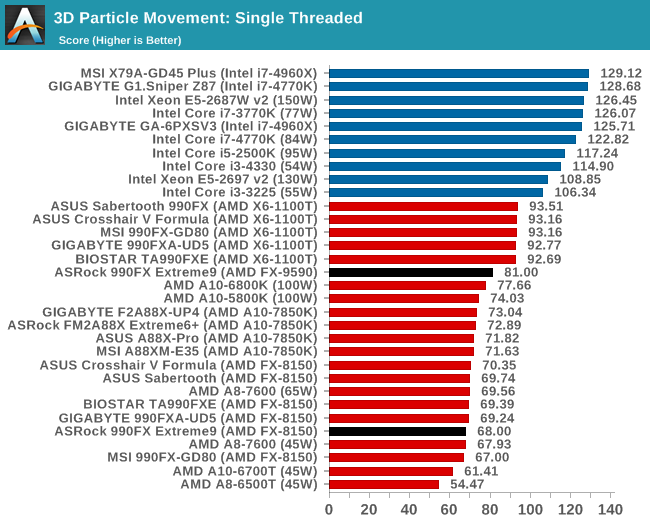

Compression – WinRAR 5.0.1: link
Our WinRAR test from 2013 is updated to the latest version of WinRAR at the start of 2014. We compress a set of 2867 files across 320 folders totaling 1.52 GB in size – 95% of these files are small typical website files, and the rest (90% of the size) are small 30 second 720p videos.
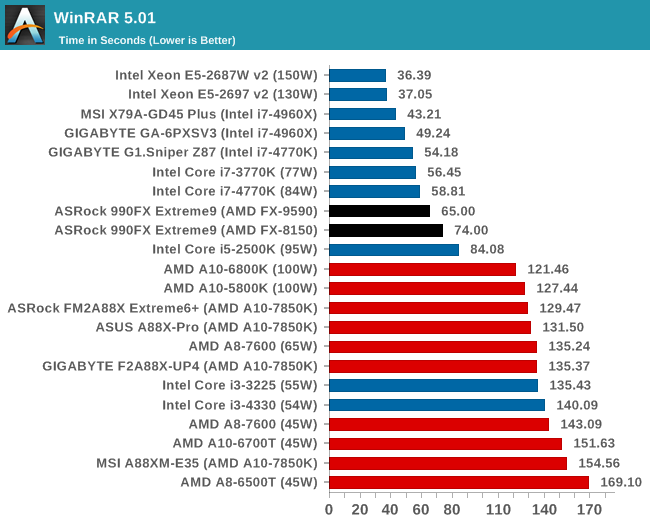
Image Manipulation – FastStone Image Viewer 4.9: link
FastStone is the program I use to perform quick or bulk actions on images, such as resizing, adjusting for color and cropping. In our test we take a series of 170 images in various sizes and formats and convert them all into 640x480 .gif files, maintaining the aspect ratio. FastStone does not use multithreading for this test, and results are given in seconds.
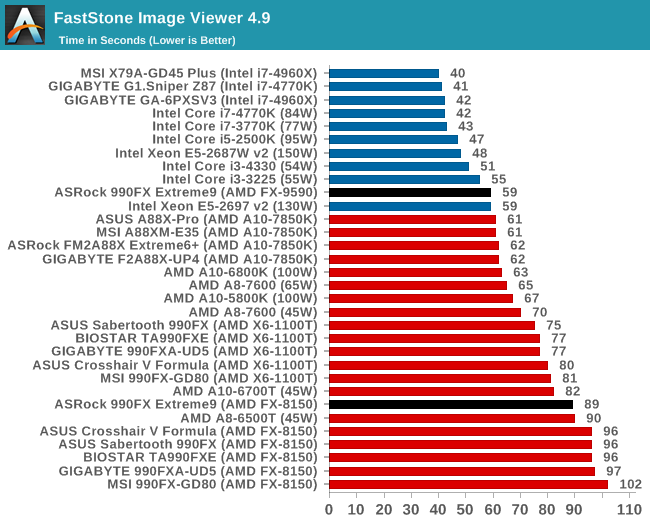
The FX-8150 result for the Extreme9 compared to other motherboards shows one of two things - the latest Windows SP1 with core parking updates has an effect, or the BIOS is more efficient at handling turbo modes than our older reviews.
Video Conversion – Handbrake v0.9.9: link
For HandBrake, we take two videos (a 2h20 640x266 DVD rip and a 10min double UHD 3840x4320 animation short) and convert them to x264 format in an MP4 container. Results are given in terms of the frames per second processed, and HandBrake uses as many threads as possible.
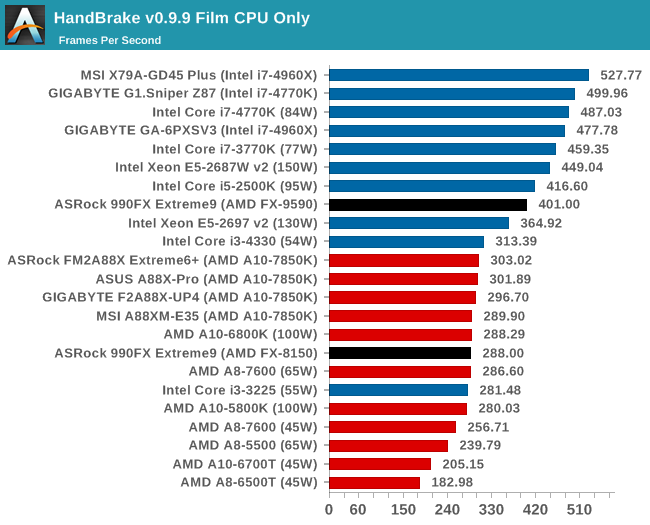

Rendering – PovRay 3.7: link
The Persistence of Vision RayTracer, or PovRay, is a freeware package for as the name suggests, ray tracing. It is a pure renderer, rather than modeling software, but the latest beta version contains a handy benchmark for stressing all processing threads on a platform. We have been using this test in motherboard reviews to test memory stability at various CPU speeds to good effect – if it passes the test, the IMC in the CPU is stable for a given CPU speed. As a CPU test, it runs for approximately 2-3 minutes on high end platforms.
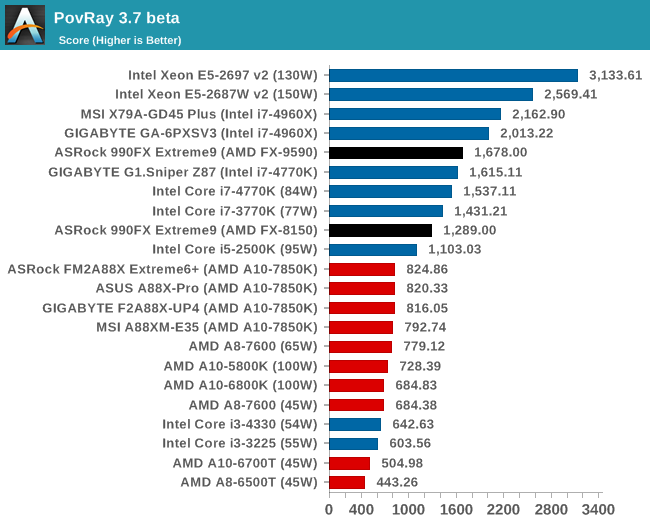
Synthetic – 7-Zip 9.2: link
As an open source compression tool, 7-Zip is a popular tool for making sets of files easier to handle and transfer. The software offers up its own benchmark, to which we report the result.
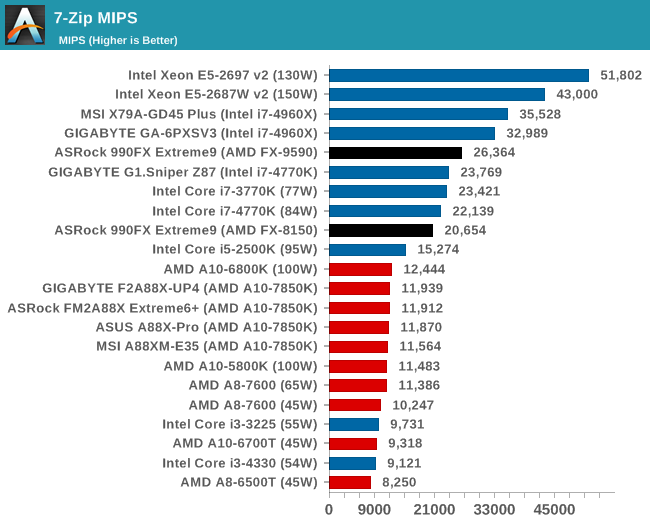










146 Comments
View All Comments
Sushisamurai - Saturday, August 9, 2014 - link
I think you guys are a little too harsh. The architecture was developed 2012-2013, so realistically, this is a sandy bridge/ivy bridge comparison. If you were to OC an ivy bridge/sandy bridge to this performance, you'd be looking at similar wattage (I'm guessing here, 5GHz on ivy/sandy doesn't seem possible on CLC). The fact it comes close to haswell for a year or two old part, I consider that a winDaniel Egger - Saturday, August 9, 2014 - link
Who cares when it was developed to do a comparison. They release it today so it has to compare against todays CPUs and this one sucks on so many levels it's not even funny anymore. Also no sane person cares about clock, it's either single- or multithread performance plus sometimes iGPU performance and of course efficiency, if you want crazy clocks you can dig out some Netburst Pentiums... Last but not least if you desperately want to see this PoC loose in some benchmarks against some mainstream Sandy Bridge CPU then have a look at the graphs and check for "Core i5-2500K".TiGr1982 - Saturday, August 9, 2014 - link
Indeed, clocks comparison does not work in terms of performance comparison between different microarchitectures.One simple number:
Haswell in single thread is around 70% faster (~1.7 times) than Piledriver (say, in Cinebench 1 thread) at the same clocks. ~70%. Check yourself. Nuff said.
Fouquin - Sunday, August 10, 2014 - link
Except they didn't release it today, they released it 14 months ago. So really, it's still an IB - FX comparison. AT was just really slow to put any press on this chips existence. It has no purpose other than to show the limit of the Bulldozer architecture, and it does that quite nicely. (Although I have an FX-8350 running at 5.12, so it isn't even the upper limits.)Really when it comes down to it though, it's a "for fun" chip. Like a super-car: it looks and acts fast, costs way too much, sucks down gas by the gallon, and is complete excess to your needs. But hey, it's shiny and looks good in the garage.
TiGr1982 - Saturday, August 9, 2014 - link
In fact, Sandy Bridge is much more efficient and has much higher IPC than Piledriver. So, Sandy Bridge i7 Core i7-2600K/2700K has to be overclocked around 4.3 GHz to match or surpass FX-9590. Ivy Bridge has slightly better IPC, than Sandy, so that 4.1-4.2 GHz should suffice for Ivy Bridge Core i7-3770K to match or surpass FX-9590. And this is for full multithreading.For single threading, Sandy and Ivy are already faster at stock turbo frequencies than anything Piledriver can offer. Piledriver has to be clocked beyond 6 GHz to try to match Core i7 stock single thread (LN2 may help, actually :)).
Yes, single-threaded performance is not so important these days, as many people like to point out, but lack of single-threaded performance is still a considerable drawback.
Sushisamurai - Saturday, August 9, 2014 - link
Yes, I realized clock to clock comparison doesn't really work - it would work if IPC was similar between different micro architectures... and well... I was over simplifying things. But, on the benchmarks, this FX core does seem to catch up to the i7-2500.My main point was to emphasize that this CPU has been around for a while, and was only recently "released" to the general public as opposed to OEM's. Had this been available when it was developed, it might have made a bigger difference for AMD - which could have potentially kept them in the CPU race.
TiGr1982 - Saturday, August 9, 2014 - link
Well, to make a bigger difference, it had to be WIDELY released a year ago (say, around initial Haswell release) for, say, $250-280 (and not $350) for retail, and be supported immediately with at least 5-7 new MOBOs capable of working with 220W TDP out of the box. Since it did not happen, now it is maybe "too little, too late" - especially, considering the facts, that:1) Devil's Canyon Core i7-4790K is already on sale, and it costs the same $$$ as last year's Core i7-4770K. Core i7-4790K is even further ahead of FX-9590 in terms of performance at stock (4.0-4.4 Ghz) and i7-4790K is even a little further overclockable to around 4.5-4.6 GHz with no issues, and FX-9590 is actually not.
2) Haswell-E is coming, and the cheapest Haswell-E, rumored to be Core i7-5820K, is supposed to have 6 Haswell cores and cost something around $400. This is of course worth thinking about for the people getting/building a new desktop machine.
mapesdhs - Tuesday, August 12, 2014 - link
Alas AFAIK the 5820K is a 4-core. 5930K is 6-core, 5960X is 8-core.
Ian.
TiGr1982 - Wednesday, August 13, 2014 - link
Not really; so far, all the sources point that Core i7-5820K will be 6 core - unlike Core i7-4820K and Core i7-3820 before it.mapesdhs - Tuesday, August 12, 2014 - link
SB is such a nice chip. Every 2700K I've obtained has happily run at 5GHz no problem,takes just a few minutes on a board like the ASUS M4E/Z. Built five of them so far. And
unlike the latest HW, it won't throttle because the temps are still good.
Ian.